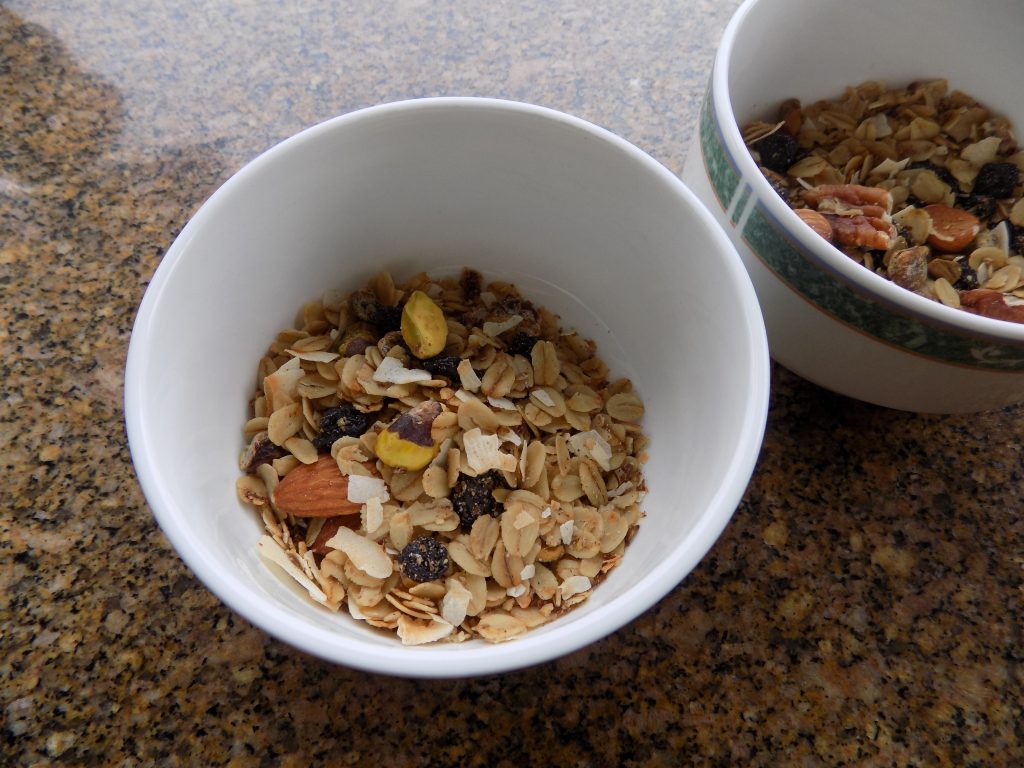
So, here goes. I am on a mission to reduce sugar in our diet. So, that means, I will be posting recipes that fit into our new lifestyle. While I know many of you are much younger than we are and have no need to change your eating habits. The fact remains that Mr. C. and I both need to eat a bit healthier. And of course, that will impact the type of recipes I post. But fear not. For those of you who are familiar with this site, you know that I have previously posted many recipes that contain an abundance of every type of ingredient that is not considered “healthy”. So, if you are into cookies, cakes, breads, desserts, high fat cream sauces, gravies etc. etc., you need not look elsewhere. I’ve still got you covered.
But that was the old me. (Actually, the young me.) And the new me (really the old me) needs to make the change. Of course, being about as human as one can get, I will undoubtedly slip once-in-a-while and come up with possibly the most sinfully caloric recipe ever invented. My hope is that this will not happen. At least not very often. But I have been living in this skin for a long time. And I know my limitations. Just please send good thoughts my way. Healthy, low-calorie thoughts that is! Anyway, back to this recipe.
My daughter Paula has been touting the benefits of using monk fruit sweetener for some time now. I bought some about a year ago, tried it, and promptly sent her the rest of the package. Then when she was up for Thanksgiving this past year, she made granola while she was here. Brought all the ingredients with her. And of course, she used monk fruit as the sweetening agent. The granola was delicious. I’d give you the recipe, but Paula is not one of those cooks, unlike me, who uses a recipe. She just goes for it. And the amazing thing is – her food always tastes wonderful. It must be all those chemistry classes she took in college. Whatever it is, she didn’t get the “wing it” gene from me! Thus, no recipe from her to share with you.
Well, the upshot is – I bought another package of monk fruit and am going to be using it more and more. At least I’m going to give it the old college try!! Ra ra sis boom bah. (Humbug, that is!)
So, if you too want to cut down on sugar and build a granola that is both healthy and delicious, give this recipe a try.
Well, that’s it for today. I’m making Ground Beef and Black Bean Chili for dinner. And I’m going to make cornbread to go with it. But this cornbread is an experiment. I am going to use whole wheat flour and a bit of monk fruit sweetener. If it turns out good, happy day. If not, you will not be hearing from me about the joys of using monk fruit sweetener instead of maple syrup.
Peace and love to all.
½ c. extra virgin olive oil
2 T. monk fruit sweetener*
1 tsp. vanilla
1 tsp. kosher salt
1 tsp. ground cinnamon
½ tsp. ground nutmeg
⅓ c. flaxseed meal
6 c. old-fashioned rolled oats
3 c. mixed nuts (almonds, walnuts, pistachios, pecans, cashews, peanuts)
1 c. flaked unsweetened coconut
3 c. dried fruit (chopped if necessary) (apricots, dates, blueberries, cranberries, cherries, raisins, etc.)
Preheat oven to 300-degrees.
In a large mixing bowl, whisk the olive oil, monk fruit sweetener, vanilla, salt, cinnamon, nutmeg, and flaxseed meal together. Then stir in the oats. Spread mixture on a rimmed baking sheet in an even layer and bake for 25 minutes. (Don’t wash the bowl.)
Add the nuts and coconut. Bake for an additional 20 minutes or until the oats are a light golden brown.
Remove from oven and transfer the granola back to the large bowl and add the dried fruit tossing to combine.
Allow to cool completely before storing in an airtight container.
*According to Food Insight, “Monk fruit, also known as lo han guo or Swingle fruit, is a small round fruit native to southern China. Monk fruit sweeteners are no-calorie sweeteners that can be used to lower one’s intake of added sugars, while still providing satisfaction to enjoy the taste of something sweet. Some types of sweeteners in this category are considered low-calorie — such as aspartame, and others are no-calorie (e.g., monk fruit sweeteners, stevia sweeteners and sucralose). However, collectively they are often referred to as sugar substitutes, high-intensity sweeteners, nonnutritive sweeteners, low- and no-calorie sweeteners or simply low-calorie sweeteners.
Like other no-calorie sweeteners, monk fruit sweeteners are intensely sweet. Monk fruit sweeteners range from being 150-200 times sweeter than sugar, and as such only small amounts are needed in a product to equal the sweetness provided by sugar. Monk fruit sweeteners can be used in a wide range of beverages and foods like soft drinks, juices, dairy products, desserts, candies, and condiments. Because they are stable at high temperatures, monk fruit sweeteners can be used in baked goods. However, a recipe that uses monk fruit sweeteners in place of sugar may turn out slightly different because in addition to sweetness, sugar plays several roles in recipes related to volume and texture, but this varies based on the type of recipe.
Several brands, such as Monk Fruit In The Raw®, Lakanto®, SPLENDA® Monk Fruit Sweetener, SweetLeaf® and Whole Earth® use monk fruit sweeteners in granular and liquid forms.”
